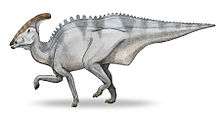Charonosaurus
| Charonosaurus jiayinensis Temporal range: Late Cretaceous, 66 Ma | |
|---|---|
| | |
| Reconstructed skull | |
| Scientific classification | |
| Kingdom: | Animalia |
| Phylum: | Chordata |
| Class: | Reptilia |
| Clade: | Dinosauria |
| Order: | †Ornithischia |
| Suborder: | †Ornithopoda |
| Family: | †Hadrosauridae |
| Tribe: | †Parasaurolophini |
| Genus: | †Charonosaurus Godefroit, Zan & Jin, 2000 |
| Species: | †C. jiayinensis |
| Binomial name | |
| Charonosaurus jiayinensis Godefroit, Zan & Jin, 2000 | |
Charonosaurus (/kəˌroʊnəˈsɔːrəs/ kə-ROH-nə-SAWR-əs; meaning "Charon's lizard") is the name of a genus of dinosaur whose fossils were discovered by Godefroit, Zan & Jin in 2000 on the south bank of the Amur River, dividing China from Russia.
Description

Charonosaurus is a very large lambeosaurine hadrosaur (estimated around 10 m (33 ft) long),[1] known from a partial skull (Holotype: CUST J-V1251-57 (Changchun University of Sciences and Technology, Changchun, Jilin Province, China) found in the Late Maastrichtian Yuliangze Formation, west of Jiayin village, Heilongjiang Province, northeastern China. Adult and juvenile hadrosaur remains discovered in the same area and formation likely represent the same taxon and supply information on most of the postcranial skeleton; the femur length was up to 1.35 m. (4.5 ft). The partial skull resembles that of Parasaurolophus and probably had a similar long, backward-projecting hollow crest, indicated by the highly modified dorsal surface of the frontal bones. Charonosaurus is one of the largest hadrosaurs currently known from Asia and indicates that lambeosaurines survived until the very end of the Cretaceous (lambeosaurines are not known from the Late Maastrichtian in North America).[2]
See also
References
- ↑ Holtz, Thomas R. Jr. (2012) Dinosaurs: The Most Complete, Up-to-Date Encyclopedia for Dinosaur Lovers of All Ages, Winter 2011 Appendix.
- ↑ Godefroit, Pascal; Shuqin Zan; Liyong Jin (2000). "Charonosaurus jiayinensis n. g., n. sp., a lambeosaurine dinosaur from the Late Maastrichtian of northeastern China". Compte Rendus de l'Academie des Sciences, Paris, Sciences de la Terre et des planètes. 330: 875–882. Bibcode:2000CRASE.330..875G. doi:10.1016/S1251-8050(00)00214-7.